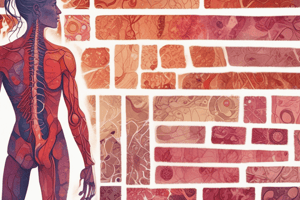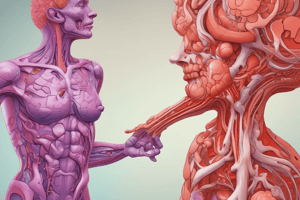Podcast
Questions and Answers
What is the definition of inflammation?
What is the definition of inflammation?
- A normal response of non-vascularized tissue to injury
- A permanent response of vascularized tissue to injury
- A chronic response of vascularized tissue to injury
- A dynamic response of vascularized tissue to injury (correct)
What is the purpose of inflammation?
What is the purpose of inflammation?
- To cause more damage to the tissue
- To get rid of the injury or infection (correct)
- To cause chronic inflammation
- To prevent healing
What is the result of increased permeability and increased hydrostatic pressure?
What is the result of increased permeability and increased hydrostatic pressure?
- Formation of a cyst
- Formation of fluid exudate (correct)
- Formation of a scar
- Formation of a blood clot
What type of cells are involved in the acute inflammatory response?
What type of cells are involved in the acute inflammatory response?
What is the term for the migration of leukocytes across the endothelium and vessel wall?
What is the term for the migration of leukocytes across the endothelium and vessel wall?
What is the term for the initial slowing of leukocytes along the endothelial surface?
What is the term for the initial slowing of leukocytes along the endothelial surface?
What is the term for the directional movement of leukocytes towards a chemical attractant?
What is the term for the directional movement of leukocytes towards a chemical attractant?
What is the term for the engulment and digestion of foreign particles and microorganisms?
What is the term for the engulment and digestion of foreign particles and microorganisms?
What is the term for the sequence of events that leads to the formation of inflammatory exudate?
What is the term for the sequence of events that leads to the formation of inflammatory exudate?
What is the term for the process by which the endothelial cells contract, leading to increased permeability?
What is the term for the process by which the endothelial cells contract, leading to increased permeability?
What is the characteristic of the pus in Cellulitis?
What is the characteristic of the pus in Cellulitis?
Which type of inflammation is characterized by localized abscesses?
Which type of inflammation is characterized by localized abscesses?
What is the term for the directed movement of inflammatory cells towards the site of injury under the effect of chemical mediators?
What is the term for the directed movement of inflammatory cells towards the site of injury under the effect of chemical mediators?
What is the name of the tract that communicates between a deep abscess and the surface?
What is the name of the tract that communicates between a deep abscess and the surface?
What is the process by which phagocytic cells recognize and engulf foreign particles and dead tissue, followed by their degradation?
What is the process by which phagocytic cells recognize and engulf foreign particles and dead tissue, followed by their degradation?
Which type of non-suppurative inflammation is characterized by a local defect in the surface?
Which type of non-suppurative inflammation is characterized by a local defect in the surface?
What type of acute inflammation is characterized by pus formation?
What type of acute inflammation is characterized by pus formation?
What is the term for the spread of infection through the bloodstream?
What is the term for the spread of infection through the bloodstream?
Which type of non-suppurative inflammation is characterized by a fibrinous exudate?
Which type of non-suppurative inflammation is characterized by a fibrinous exudate?
What is the name of the enzyme responsible for fibrin deposition and localization of the infection site?
What is the name of the enzyme responsible for fibrin deposition and localization of the infection site?
What is the term for a small abscess related to a hair follicle?
What is the term for a small abscess related to a hair follicle?
What is the term for the spread of infection through the lymphatic system?
What is the term for the spread of infection through the lymphatic system?
Which type of non-suppurative inflammation is characterized by a pseudomembrane?
Which type of non-suppurative inflammation is characterized by a pseudomembrane?
What is the term for a large subcutaneous deep abscess that opens in the skin by multiple sinuses?
What is the term for a large subcutaneous deep abscess that opens in the skin by multiple sinuses?
What is the outermost zone of an abscess that consists of inflammatory cells?
What is the outermost zone of an abscess that consists of inflammatory cells?
What is the term for the protein-based substance that makes up the outermost layer of an abscess?
What is the term for the protein-based substance that makes up the outermost layer of an abscess?
Flashcards are hidden until you start studying
Study Notes
Definition and Purpose of Inflammation
- Inflammation is a dynamic response of vascularized tissue to injury, aiming to get rid of the injurious agent or damaged tissue.
- The process involves vascular changes leading to the formation of inflammatory exudate.
Types of Inflammation
- Gastritis: inflammation of the stomach
- Appendicitis: inflammation of the appendix
- Tonsillitis: inflammation of the tonsil
- Hepatitis: inflammation of the liver
- Cholecystitis: inflammation of the gallbladder
- Pneumonia: inflammation of the lung
- Pleurisy: inflammation of the pleura
Causes of Inflammation
- Chemical: acid, alkali
- Physical: heat, cold, trauma
- Infection: bacteria, virus, fungal
- Immunological: effectiveness of nature of stimulus and protective mechanisms
Acute Inflammation
- Rapid onset and short duration
- Characterized by prominent vascular response and neutrophils
- Aims to remove the agent/tissue damage and form fluid and cellular exudate
- Vascular changes: transient vasoconstriction, vasodilation, and increased permeability
- Formation of fluid exudate: vasodilation, increased hydrostatic pressure, and increased osmotic pressure
Vascular Reactions
- Exudation: change in caliber, increased permeability, endothelial cell contraction, and endothelial damage
- Transcytosis: protein-rich fluid (fluid exudate)
Leukocyte Journey
- Margination: due to stasis, leukocytes come peripheral along endothelial cells
- Rolling and adhesion to endothelial cells
- Migration across the endothelium and vessel wall: diapedesis or transmigration
- Chemotaxis: directed movement of inflammatory cells toward the site of injury under the effect of chemical mediators (chemoattractant)
- Phagocytosis: recognition and engulfment of foreign particles, followed by their degradation
Types of Acute Inflammation
- Suppurative (with pus formation): characterized by pus formation
- Non-suppurative (without pus formation): characterized by absence of pus formation
Suppurative Inflammation
- Mechanism of pus formation: bacteria, tissue necrosis, attraction of neutrophils, dead neutrophils, and pus
- Types of suppurative inflammation: localized (abscess, furuncle, carbuncle) and diffuse (cellulitis, peritonitis)
Non-suppurative Inflammation
- Fibrinous (e.g., pneumonia)
- Serous (e.g., burn)
- Serofibrinous (e.g., serous sac)
- Catarrhal (e.g., rhinitis, pharyngitis)
- Pseudomembranous (e.g., diphtheria)
- Haemorrhagic (e.g., smallpox)
- Necrotizing (e.g., cancrum oris)
- Allergic (e.g., urticaria)
Complications of Inflammation
- Resolution: tissue destruction, fibrosis, and chronic inflammation
- Complications of abscess: sinus, fistula, ulcer
- Spread of infection: direct, toxemia, blood, lymphatic, pyemia, and septicemia
Studying That Suits You
Use AI to generate personalized quizzes and flashcards to suit your learning preferences.





